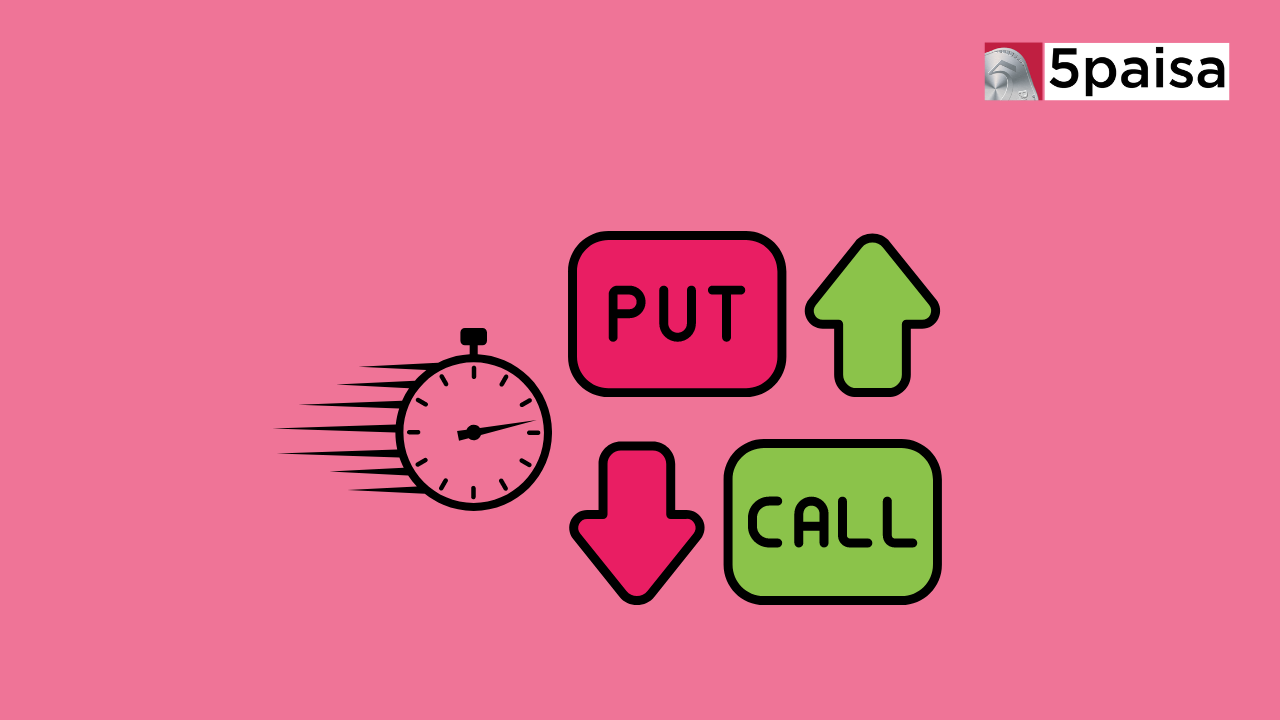Stock specific unwinding leading to underperformance in midcap and small cap
Time Decay

Last Updated: 11th October 2024 - 03:15 pm
Time is a critical factor in options trading that can significantly impact an option contract's value and potential profitability. One concept that options traders need to be familiar with is "time decay," which refers to the gradual erosion of an option's value as it expires. This phenomenon is a natural consequence of the time-sensitive nature of options and can significantly affect trading strategies and decision-making.
What Is Time Decay?
Top Stocks to Buy
As of: 21 Feb, 2025 03:58 PM
| Company | LTP | Market Cap (Cr.) | PE Ratio | 52W High | 52W Low |
|---|---|---|---|---|---|
| Tata Consultancy Services Ltd | 3,786.00 | ₹ 1,369,807.93 | 28.09 | 4,592.25 | 3,591.50 |
| Reliance Industries Ltd | 1,228.15 | ₹ 1,661,977.92 | 24.01 | 1,608.80 | 1,193.35 |
| Tata Consultancy Services Ltd | 3,786.00 | ₹ 1,369,807.93 | 28.09 | 4,592.25 | 3,591.50 |
| Tata Chemicals Ltd | 846.05 | ₹ 21,553.97 | -38.52 | 1,349.00 | 831.80 |
| Adani Green Energy Ltd | 849.35 | ₹ 134,539.80 | 98.63 | 2,174.10 | 840.45 |
| Asian Paints Ltd | 2,257.60 | ₹ 216,548.49 | 51.16 | 3,394.90 | 2,185.70 |
| Indian Railway Finance Corporation Ltd | 125.11 | ₹ 163,500.08 | 25.00 | 229.00 | 116.65 |
| Adani Enterprises Ltd | 2,133.10 | ₹ 246,198.29 | 66.52 | 3,743.90 | 2,025.00 |
| Asian Energy Services Ltd | 229.80 | ₹ 1,028.92 | 30.21 | 444.15 | 220.40 |
| Asian Paints Ltd | 2,257.60 | ₹ 216,548.49 | 51.16 | 3,394.90 | 2,185.70 |
| Tata Consultancy Services Ltd | 3,786.00 | ₹ 1,369,807.93 | 28.09 | 4,592.25 | 3,591.50 |
| Bajaj Auto Ltd | 8,506.05 | ₹ 237,537.92 | 31.52 | 12,774.00 | 7,890.00 |
| Bajaj Consumer Care Ltd | 161.25 | ₹ 2,307.12 | 17.78 | 288.95 | 158.91 |
| Berger Paints India Ltd | 491.25 | ₹ 57,274.58 | 50.22 | 629.50 | 437.75 |
| Hindustan Unilever Ltd | 2,241.65 | ₹ 526,696.13 | 49.03 | 3,035.00 | 2,172.05 |
Time decay, also known as theta decay or theoretical erosion, is the rate at which an option's premium (the price paid for the option) diminishes over time solely due to the passage of time. It is an inherent characteristic of options and occurs regardless of the underlying asset's price movement.
In simple terms, an option contract grants the holder the right, but not the obligation, to buy (call option) or sell (put option) an underlying asset at a predetermined price (strike price) by a specific expiry date. As the expiration date approaches, the value of this option right diminishes, decreasing the option's premium.
This decrease in value occurs because the probability of the option finishing in the money (profitable) diminishes as time passes. Consequently, the time value component of the option's premium, which represents the potential for future price movements, gradually decays.
How Time Decay Works?
To better understand how time decay works, let's break it down into key factors:
● Time to Expiry: The closer an option gets to its expiry date, the faster the rate of time decay. Options with longer expiration dates have a slower decay rate than those with shorter expiration periods.
● Intrinsic Value: Options that are in-the-money (ITM), where the intrinsic value (the difference between the underlying asset's price and the strike price) is positive, are less susceptible to time decay compared to out-of-the-money (OTM) options with no intrinsic value.
● Volatility: Options on underlying assets with higher implied volatility tend to decay slower than those with lower volatility. Higher volatility suggests a greater chance of the option becoming profitable before expiry, hence a slower time decay rate.
● Interest Rates: Higher interest rates can accelerate time decay, particularly for out-of-the-money call options. This is because the time value of money increases with higher interest rates, making it less attractive to hold an option that may not become profitable.
How Does Time Decay Affect Options Pricing?
Time decay plays a crucial role in determining an option contract's fair value or premium. As time passes, the time value component of the option's premium gradually decreases, resulting in a lower overall premium.
This effect is most pronounced for at-the-money (ATM) options, where the strike price is close to the underlying asset's current price. Since these options have no intrinsic value, their premium consists primarily of time value, which decays rapidly as expiration approaches.
Out-of-the-money (OTM) options, where the strike price is unfavorably compared to the underlying asset's current price, are also significantly impacted by time decay. As the expiration date nears, the likelihood of these options becoming profitable diminishes, leading to a faster rate of time decay.
Time Decay Benefits
While time decay may seem like a disadvantage for option buyers, it can also present opportunities for option sellers or writers. Here are some potential benefits of time decay:
● Slower Time Decay Early On: In the early stages of an option's life, time decay progresses slowly, adding value or premium to the option. This allows investors to sell the option while it still holds significant value.
● Determining Option Profitability: The impact of time decay on an option's premium can help investors determine whether it's worth pursuing. Options with a high rate of time decay may not be attractive for long-term holding.
● Favourable for Option Sellers: Time decay benefits option sellers or writers. As the value of the option gradually decreases, the buyer is less likely to exercise it. If the option expires worthless, the seller retains the entire premium.
Example of Time Decay
To illustrate the concept of time decay, let's consider an example:
An investor is considering buying a call option on a stock with a strike price of ₹200 and a premium of ₹10 per contract. The option has two months until expiration. The investor expects the stock to trade at ₹220 or higher by expiration.
However, another call option with the same strike price of ₹200 but only one week until expiration has a premium of ₹2 per contract. This option costs significantly less than the two-month option because the likelihood of the stock moving higher by a substantial amount in just one week is relatively low.
In this example, the one-week option's extrinsic (time) value is lower than the two-month option, as the time value component decays rapidly as the expiration date approaches.
Difference Between Time Decay and Moneyness
| Difference | Time Decay | Moneyness |
| Definition | Time decay refers to the reduction in an option's value as it approaches expiration. | Moneyness indicates the profitability level of an option based on its intrinsic value. |
| Importance | Time decay impacts the option's premium, especially its time value component. | Moneyness determines if an option is profitable or not. |
| Categories | Not categorised. | - In-the-money (ITM): Positive intrinsic value. <br> - At-the-money (ATM): Strike price is equal to or close to the underlying asset's price. <br> - Out-of-the-money (OTM): No intrinsic value. |
| Impact on Options | Most prevalent in at-the-money (ATM) options; accelerates for out-of-the-money (OTM) options. | In-the-money (ITM) options are less affected by time decay due to existing intrinsic value. |
| Profitability | Does not directly indicate profitability. | Directly indicates the profitability of the option |
Conclusion
Time decay is a critical concept in options trading that traders should understand and factor into their decision-making process. It represents the gradual erosion of an option's value as it approaches its expiration date, and it affects options differently depending on their moneyness, volatility, and time to expiration. While time decay can disadvantage option buyers, it also presents opportunities for option sellers or writers. By understanding how time decay works and its impact on options pricing, traders can make more informed decisions and potentially improve their overall trading performance.
Frequently Asked Questions
Why Is Time Decay More Pronounced in Options Than in Other Financial Instruments?
Does Time Decay Impact Both Buyers and Sellers of Options Equally?
How Does the Time to Expiration Affect the Magnitude of Time Decay?
- Flat ₹20 Brokerage
- Next-gen Trading
- Advance Charting
- Actionable Ideas
Trending on 5paisa
Futures and Options Related Articles
Disclaimer: Investment in securities market are subject to market risks, read all the related documents carefully before investing. For detailed disclaimer please Click here.
 5paisa Research Team
5paisa Research Team
 Sachin Gupta
Sachin Gupta




